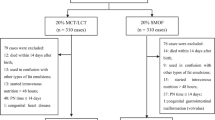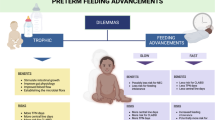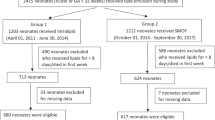Abstract
Intravenous lipid emulsions (ILEs) are an essential component of parenteral nutrition for very preterm and very low birth weight infants (VLBWs). This article offers a perspective on advancements and controversies on ILE use in this population. ILEs prescribed after birth at a dose of 1.5–2 g/kg/day and advanced to 3 g/kg/day enhance growth. Growth appears to be similar for infants who receive an ILE composed of 100% soybean oil or a multi-oil ILE with 15% fish oil. 100% fish oil is the preferred ILE for the management of parenteral nutrition associated cholestasis and intestinal failure associated liver disease. Research is warranted to help determine how we can optimize ILEs to improve neurodevelopment and prematurity complications. Last, we lack a universal definition of hypertriglyceridemia (HTG) and consensus on triglyceride surveillance and HTG management. Investigation is required to determine the health impact of specific triglyceride ranges in very preterm infants and VLBWs.
This is a preview of subscription content, access via your institution
Access options
Subscribe to this journal
Receive 12 print issues and online access
$259.00 per year
only $21.58 per issue
Buy this article
- Purchase on Springer Link
- Instant access to full article PDF
Prices may be subject to local taxes which are calculated during checkout

Similar content being viewed by others
References
Griffin IJ, Tancredi DJ, Bertino E, Lee HC, Profit J. Postnatal growth failure in very low birthweight infants born between 2005 and 2012. Arch Dis Child Fetal Neonatal Ed 2016;101:F50–5.
Stephens BE, Walden RV, Gargus RA, Tucker R, McKinley L, Mance M, et al. First-week protein and energy intakes are associated with 18-month developmental outcomes in extremely low birth weight infants. Pediatrics. 2009;123:1337–43.
Vlaardingerbroek H, Vermeulen MJ, Rook D, van den Akker CH, Dorst K, Wattimena JL, et al. Safety and efficacy of early parenteral lipid and high-dose amino acid administration to very low birth weight infants. J Pediatr. 2013;163:638–44.e1-5.
Alburaki W, Yusuf K, Dobry J, Sheinfeld R, Alshaikh B. High early parenteral lipid in very preterm infants: a randomized-controlled trial. J Pediatr. 2021;228:16–23.e1.
Drenckpohl D, McConnell C, Gaffney S, Niehaus M, Macwan KS. Randomized trial of very low birth weight infants receiving higher rates of infusion of intravenous fat emulsions during the first week of life. Pediatrics. 2008;122:743–51.
Kim K, Kim NJ, Kim SY. Safety and efficacy of early high parenteral lipid supplementation in preterm infants: a systematic review and meta-analysis. Nutrients. 2021;13:1535.
Lapillonne A, Fidler Mis N, Goulet O, van den Akker CHP, Wu J, Koletzko B, et al. ESPGHAN/ESPEN/ESPR/CSPEN guidelines on pediatric parenteral nutrition: lipids. Clin Nutr. 2018;37:2324–36.
Clandinin MT, Chappell JE, Leong S, Heim T, Swyer PR, Chance GW. Intrauterine fatty acid accretion rates in human brain: implications for fatty acid requirements. Early Hum Dev. 1980;4:121–9.
Kim ES, Lee LJ, Romero T, Calkins KL. A multi-oil intravenous lipid emulsion with fish oil: clinical outcomes and red blood cell membrane polyunsaturated fatty acids in extremely low birth weight infants. J Parenter Enteral Nutr. 2022.
Costa S, Cocca C, Barone G, Catenazzi P, Gallini F, Maggio L, et al. Growth of head circumference and body length in preterm infants receiving a multicomponent vs a soybean-based lipid emulsion: a randomized controlled trial. J Parenter Enter Nutr. 2021;45:94–101.
Repa A, Binder C, Thanhaeuser M, Kreissl A, Pablik E, Huber-Dangl M, et al. A mixed lipid emulsion for prevention of parenteral nutrition associated cholestasis in extremely low birth weight infants: a randomized clinical trial. J Pediatr. 2018;194:87–93.e1.
Skouroliakou M, Konstantinou D, Koutri K, Kakavelaki C, Stathopoulou M, Antoniadi M, et al. A double-blind, randomized clinical trial of the effect of omega-3 fatty acids on the oxidative stress of preterm neonates fed through parenteral nutrition. Eur J Clin Nutr. 2010;64:940–7.
Thanhaeuser M, Fuiko R, Oberleitner-Leeb C, Brandstaetter S, Binder C, Thajer A, et al. A randomized trial of parenteral nutrition using a mixed lipid emulsion containing fish oil in infants of extremely low birth weight: neurodevelopmental outcome at 12 and 24 months corrected age, a secondary outcome analysis. J Pediatr. 2020;226:142–8.e5.
Vlaardingerbroek H, Vermeulen MJ, Carnielli VP, Vaz FM, van den Akker CH, van Goudoever JB. Growth and fatty acid profiles of VLBW infants receiving a multicomponent lipid emulsion from birth. J Pediatr Gastroenterol Nutr. 2014;58:417–27.
Phase 3 study to compare safety and efficacy of smoflipid 20% to intralipid 20% in hospitalized neonates and infants. https://ClinicalTrials.gov/show/NCT02579265.
Kapoor V, Malviya MN, Soll R. Lipid emulsions for parenterally fed preterm infants. Cochrane Database Syst Rev. 2019;6:CD013163.
Gura K, Premkumar MH, Calkins KL, Puder M. Intravenous fish oil monotherapy as a source of calories and fatty acids promotes age-appropriate growth in pediatric patients with intestinal failure-associated liver disease. J Pediatr. 2020;219:98–105.e4.
Gura KM, Premkumar MH, Calkins KL, Puder M. Fish oil emulsion reduces liver injury and liver transplantation in children with intestinal failure-associated liver disease: a multicenter integrated study. J Pediatr. 2021;230:46–54.e2.
Gura KM, Calkins KL, Premkumar MH, Puder M. Use of intravenous soybean and fish oil emulsions in pediatric intestinal failure-associated liver disease: a multicenter integrated analysis report on extrahepatic adverse events. J Pediatr. 2022;241:173–80.e1.
Diamond IR, Grant RC, Pencharz PB, de Silva N, Feldman BM, Fitzgerald P, et al. Preventing the progression of intestinal failure-associated liver disease in infants using a composite lipid emulsion: a pilot randomized controlled trial of SMOFlipid. J Parenter Enter Nutr. 2017;41:866–77.
Hojsak I, Colomb V, Braegger C, Bronsky J, Campoy C, Domellöf M, et al. ESPGHAN Committee on Nutrition Position Paper. Intravenous lipid emulsions and risk of hepatotoxicity in infants and children: a systematic review and meta-analysis. J Pediatr Gastroenterol Nutr. 2016;62:776–92.
Ng K, Stoll B, Chacko S, Saenz de Pipaon M, Lauridsen C, Gray M, et al. Vitamin E in new-generation lipid emulsions protects against parenteral nutrition-associated liver disease in parenteral nutrition-fed preterm pigs. J Parenter Enter Nutr. 2016;40:656–71.
Le HD, Meisel JA, de Meijer VE, Fallon EM, Gura KM, Nose V, et al. Docosahexaenoic acid and arachidonic acid prevent essential fatty acid deficiency and hepatic steatosis. J Parenter Enter Nutr. 2012;36:431–41.
Correani A, Giretti I, Antognoli L, Monachesi C, Cogo P, D’Ascenzo R, et al. Hypertriglyceridemia and intravenous lipid titration during routine parenteral nutrition in small preterm infants. J Pediatr Gastroenterol Nutr. 2019;69:619–25.
Giretti I, D’Ascenzo R, Correani A, Antognoli L, Monachesi C, Biagetti C, et al. Hypertriglyceridemia and lipid tolerance in preterm infants with a birth weight of less than 1250 g on routine parenteral nutrition. Clin Nutr. 2021;40:4444–8.
Connelly PW, Maguire GF, Vezina C, Hegele RA, Kuksis A. Kinetics of lipolysis of very low density lipoproteins by lipoprotein lipase. Importance of particle number and noncompetitive inhibition by particles with low triglyceride content. J Biol Chem. 1994;269:20554–60.
Cairns PA, Stalker DJ. Carnitine supplementation of parenterally fed neonates. Cochrane Database Syst Rev. 2000;2000:CD000950.
Author information
Authors and Affiliations
Contributions
BF and KLC drafted the initial manuscript. All authors edited, critically reviewed, and approved the manuscript, and agree to be accountable for the contents of the manuscript.
Corresponding author
Ethics declarations
Competing interests
BF is an advisor and speaker for Mead Johnson Nutrition. CRM serves on the Scientific Advisory Board of Plakous Therapeutics, Vitara Biomedical, and LactaLogics, Inc. KLC has served as an advisor for Fresenius Kabi, Mead Johnson Nutrition, Baxter, and Prolacta. CRM and KLC serve as institutional principal investigators, with no salary funding, for a consortium database sponsored by Mead Johnson Nutrition.
Additional information
Publisher’s note Springer Nature remains neutral with regard to jurisdictional claims in published maps and institutional affiliations.
Rights and permissions
Springer Nature or its licensor (e.g. a society or other partner) holds exclusive rights to this article under a publishing agreement with the author(s) or other rightsholder(s); author self-archiving of the accepted manuscript version of this article is solely governed by the terms of such publishing agreement and applicable law.
About this article
Cite this article
Frost, B., Martin, C.R. & Calkins, K.L. Dilemmas in the delivery of intravenous lipid emulsions and approach to hypertriglyceridemia in very preterm and low birth weight infants. J Perinatol 43, 1189–1193 (2023). https://doi.org/10.1038/s41372-023-01637-0
Received:
Revised:
Accepted:
Published:
Issue Date:
DOI: https://doi.org/10.1038/s41372-023-01637-0



